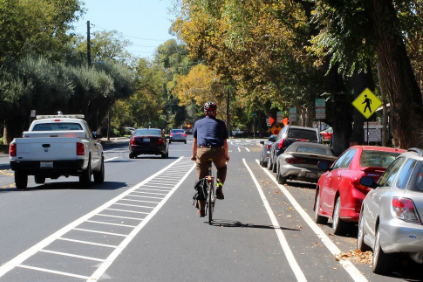Studies show that almost two-thirds of adults would consider riding their bike more often if they had better places to ride, and as many as 81% of those would ride in protected bike lanes.
Another type of bike lane, “buffered bike lane” delineates space for bicyclists but does not provide a physical separation between people cycling and driving. With on-street parking, they also place the bicycle between parked vehicles and moving motor vehicles. This can feel uncomfortable for cyclists, especially on streets with multiple vehicle lanes, high traffic volumes, and high speeds. Buffered bike lanes are also “porous”, i.e., cars can cross them at any location to enter or exit on-street parking areas. This results in additional conflicts.
Protected bikeways use physical separation – such as posts or parked vehicles – to create a space that is consistently designated for cyclists. These are recommended instead of buffered bike lanes on roads where daily traffic volumes are higher than approximately 6,000 vehicles and where vehicle speeds exceed 25 MPH, such as Rainier Avenue. Physical separation makes these bikeways safer and more comfortable for cyclists of all ages and abilities regardless of the number of lanes, traffic volumes, or speeds. Protected bikeways also improve the overall organization of the street, which increases safety for people walking, cycling, and driving (NACTO).


